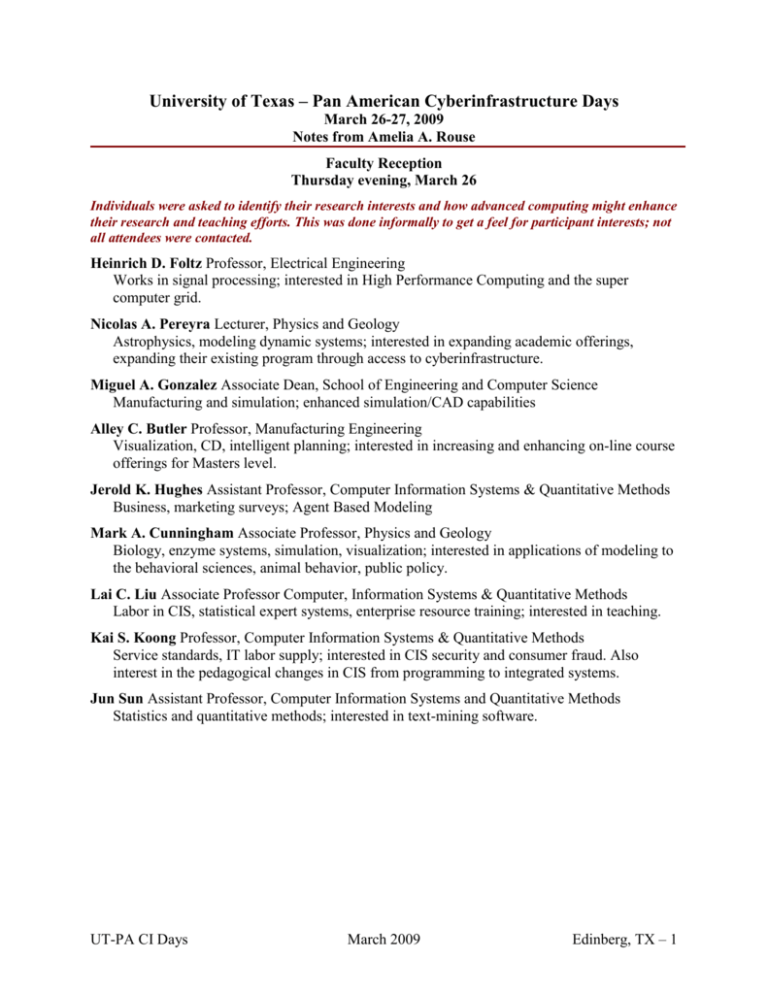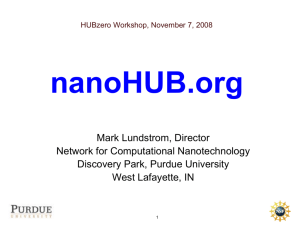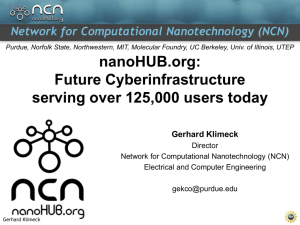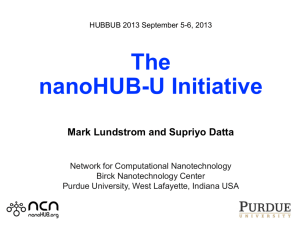UT_PA CI Days Notes - the MSI
advertisement

University of Texas – Pan American Cyberinfrastructure Days March 26-27, 2009 Notes from Amelia A. Rouse Faculty Reception Thursday evening, March 26 Individuals were asked to identify their research interests and how advanced computing might enhance their research and teaching efforts. This was done informally to get a feel for participant interests; not all attendees were contacted. Heinrich D. Foltz Professor, Electrical Engineering Works in signal processing; interested in High Performance Computing and the super computer grid. Nicolas A. Pereyra Lecturer, Physics and Geology Astrophysics, modeling dynamic systems; interested in expanding academic offerings, expanding their existing program through access to cyberinfrastructure. Miguel A. Gonzalez Associate Dean, School of Engineering and Computer Science Manufacturing and simulation; enhanced simulation/CAD capabilities Alley C. Butler Professor, Manufacturing Engineering Visualization, CD, intelligent planning; interested in increasing and enhancing on-line course offerings for Masters level. Jerold K. Hughes Assistant Professor, Computer Information Systems & Quantitative Methods Business, marketing surveys; Agent Based Modeling Mark A. Cunningham Associate Professor, Physics and Geology Biology, enzyme systems, simulation, visualization; interested in applications of modeling to the behavioral sciences, animal behavior, public policy. Lai C. Liu Associate Professor Computer, Information Systems & Quantitative Methods Labor in CIS, statistical expert systems, enterprise resource training; interested in teaching. Kai S. Koong Professor, Computer Information Systems & Quantitative Methods Service standards, IT labor supply; interested in CIS security and consumer fraud. Also interest in the pedagogical changes in CIS from programming to integrated systems. Jun Sun Assistant Professor, Computer Information Systems and Quantitative Methods Statistics and quantitative methods; interested in text-mining software. UT-PA CI Days March 2009 Edinberg, TX – 1 Facilitated Session Friday 2 pm-4 pm, March 27 Identifying Commonalities For the first exercise attendees were asked to write down the answers that filled in the blanks in the following sentence: If I had x Cyber-infrastructure capability, I could do y in teaching or research. The answers…x: y Visualization capabilities: teach people motor skill Time: research Visualization capabilities: improve information delivery in classroom. Increased access to TACC-level resources (on-line training resources; staff): increased teaching for Master’s level students (hypothetical Center for Simulation suggested as point of access) Visualization ‘bench’ including wall and immersive ‘cave’: increased teaching capabilities, CAD design, increased interdisciplinary interactions. Seamless high performance computer processing: simulation of electromagnetic structures Business enterprise level software, storage and professional licenses: text analytics, ability to teach ERP and SAP; data mining and storage/housing Real laboratory space: real physics Experimental resources, modeling capabilities; infrastructure: real physics Research administration support improve campus research culture: more research Based on this exercise, four groups formed to work together on the remaining tasks. The CI Days team experts joined with UTPA faculty as they focused on: increasing faculty awareness of CI; nanoscience and technology; development of a Center for Simulation; and a faculty project dealing with developing kinesthetic notation for dance. Recording their work on presentation-sized post-it notes, these groups identified: A Goal in their area; The Gaps between reality and their goal; Local and national assets to help them achieve their goal; and One gap to address immediately through an action plan. Action plans were reported to the rest of the attendees, comments were solicited and recorded. UT-PA CI Days March 2009 Edinberg, TX – 2 Center for Simulation Planning Group Mark A. Cunningham Associate Professor, Physics and Geology Wendy A. Lawrence-Fowler Vice Provost for Research and Sponsored Projects George Adams, Nanohub Russ Hobby, University of California, Davis; CI Team Member Alley C. Butler, Professor, Manufacturing Engineering Goal: Visualization hardware and software & support personnel for research and teaching Gap analysis: Enabling technologies Bandwidth to/from TACC Local visualization systems/hardware (local rendering) Stand alone systems (can’t be provided by TACC, etc.) Immersive Visual systems Wall Cave (stereoscopic) PC storage Haptic input/output devices Subject of Action Plan Personnel Technician-level support (Unix administrator, Masters level professional) Network optimization Assets: TACC Bambi(220 cores) Space (startup) On-going research and teaching Faculty interest (multidisciplinary) Action Plan: 1. Find external support for a Unix administrator Contact ARL (Air force Research Lab), Tidrow Department of Homeland Security (Reidhead, 1kGNU) CAE visual analytics Cuellar 2. Needs assessment (campus-wide) Make Center an agenda item on strategic research plan of UTPA Post-presentation comments from other participants: Teragrid has campus champions; you might want to explore that as an option Call it facility enhancements to increase funding potential NCSI (see Bob) is available for training in science education off -site, weeks Develop job description and career path for position Serial or coordinated funding UT-PA CI Days March 2009 Edinberg, TX – 3 Increasing Faculty Awareness of CI Group Jerold K. Hughes, Assistant Professor, Computer Information Systems & Quantitative Methods Heinrich D. Foltz, Professor Electrical Engineering Alex Ramirez, Executive Director for IT Initiatives, Hispanic Association of Colleges and Universities. Goal: State of the art currency for education and research Gaps: Subject of Action Plan Faculty need to discover what they need Ease of use of CI resources Hardware that will run needed software or use remote resources Scalable software and hardware to meet research and education needs Matlab running on HPC with access to hardware Assets: Chong and Edwards, full-time support staff in business David Kartlay support person in engineering CS and CIS faculty that want to work with other faculty COBA network allowing some control Research office is very supportive Action Plan: White paper on what it means to be technologically current Define the question, not answers Review what ‘top’ programs are doing Review and catalog campus faculty and staff technological expertise At the invitation of the department bring the national or campus experts for department meetings/retreats Visit “top” programs Comments: Office of Research can identify faculty and tailor outreach. Faculty is saturated with ‘training’; offer faculty development certificates for participation that become part of the tenure file. Next steps to get information into faculty heads; Make sure faculty understand return on investment for learning about and utilizing CI in research and teaching. UT-PA CI Days March 2009 Edinberg, TX – 4 Developing Kinesthetic Notation for Dance Group Lin Wang, Assistant Professor Health and Kinesiology Tammy L. Schreiber, Grants and Contracts Specialist I Office of Research and Sponsored Projects Jack Ox, UNM HPC and ARTS Lab Richard Alo, University Houson-Downtown, CI Team Member M?? Goal: Find a rich vocabulary to translate rhythmic elements for pedagogical purposes Gaps: Subject of Action Plan Ability to digitize the movements (Motion Capture system studio) Funding (NIH) Collaboration between colleges Assets: In-house interdisciplinary faculty Baylor College of Medicine Use of simulation center at UTPA Students Action Plan 1. Identify personnel interested in project. Simulation center Outside source 2. Funding resources (ask ORSP) Be open to all opportunities i.e., children w/movement problems Five page concept paper to address vision and objectives for the goal (Dr. Wang will have ready within 3days) 3. Rhythmic element data collection (kinetic, kinematics, etc.) 4. Translation to dance, PE. Hardware: Vicon system; Software: Visual 3D Professional Comments’ Jack and Richard willing help Damien, former student w/original data set to study Faculty in mechanical engineering might be willing to help Employ force sensors Build on existing notation first Find existing data sets to start w/basic notation. UT-PA CI Days March 2009 Edinberg, TX – 5 Nanoscience & Technology Group Karen Lozano Endowed Chair, Assoc Professor, Mechanical Engineering Mircea Chipara Assistant Professor, Physics and Geology George Adams, NanoHub Unlike the other groups who participated in the formal exercise, it was decided that the best use of time for this group was for Dr. Adams to introduce Dr. Lonzo to the resources available to her from his organization; the results of their meeting are included here. Goal: Use Nanohub platform to enhance teaching opportunities and train students (undergraduates) for 1week at the Nanohub and discuss creating a hub at UTPA. Action Plan: After being exposed to the full teaching resources of Nanohub, Dr. Lozano would review the existing tools available and determine if there were any she would like to add. Nanohub would potentially provide funding through their SURF (Student Undergraduate Research Funding) program for a team of her students to spend a week at Purdue learning rapture and modeling the modules indicated by Dr. Lozano. UT-PA CI Days March 2009 Edinberg, TX – 6











